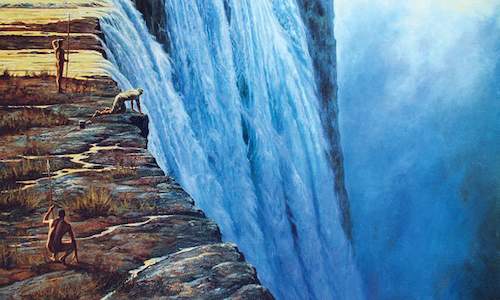Victoria Falls Becomes a Boom Town
Elephant doing a spot of window shopping in Victoria Falls.
When the river's at its highest, between March and May, over 500 million cubic metres of water cascade into the gorge every minute, creating an immense updraught which sucks sheets of water skyward as vapour and spray, only to rain down again in showers. From 30 miles away, the spray looks like a graceful line of smoke rising from a bush fire. From 60m away, at Danger Point, it's more like a monumental car wash, and the bellow is deafening. It's at this time of year that the traditional Kololo name for the Falls, 'Mosi-oa-Tunya', or 'the Smoke that Thunders', seems utterly apt.
The Victoria Falls NP encloses the Zimbabwean part of the sheer cliff that faces the Falls. Spray nurtures a pocket of lush green rainforest, a World Heritage Site, home to bushbuck, Vervet monkeys, butterflies and birds. I followed tidy paths, bordered by ferns and vine-draped ebonies, mahogonies and palms, between cliff-top viewpoints with different, eye-level, grandstand views of the mass of moving water. The section nearest Danger Point is called the Rainbow Falls, but I soon lost count of the rainbows.
As for the pots of gold - until recently, Victoria Falls had seemed strewn with them, gripping the popular imagination since the mid-19th century, when David Livingstone re-named the Falls after Queen Victoria and publicised them in his notes and lectures.
Once it was connected by rail to Bulawayo, as part of Cecil Rhodes' grand plan for a Cape to Cairo route, the site became accessible to travellers. A key moment came in 1905 with the completion of the bridge that spans the Batoka Gorge, running so close to the Falls that the spray rained down on trains as they crossed, in accordance with Rhodes' specific directions.
Visitor numbers grew steadily during the 20th century, as Victoria falls grew into a boom town, but it was the birth of the adventure sport industry in the early '80s that sent the tourist industry into orbit. By the 1990s Victoria Falls was a boom town, fizzing with new hotels and tour companies. White-water rafting was raging, punters queued up for what was then the world's highest bungee jump and new ideas for action-packed activities bounced from the drawing board into reality.
But there was growing anxiety about the boom's impact on the natural environment. Noise pollution became a serious issue, as commercial helicopters, microlights and fixed-wing planes competed for airspace over the Zambezi. Boats began to crowd the river. Controversial schemes to flout planning restrictions by building higher than tree height, and to start developing the islands upstream from the Falls, were rumoured. The town's population doubled and its infrastructure struggled to keep pace.
Zimbabwe's political disarray and negative public image have hit the tourist industry hard. Visitor numbers have plummeted, and a vital source of foreign currency has been lost. It's become a time for new approaches and creative strategic thinking.
Despite plans to erect a marker to set the record straight over the 'discovery' of the Falls (after all, there is evidence that the area has been populated since the late Stone Age), Livingstone remains a popular historical figure locally, largely thanks to his forthright stand against slavery. The statue depicts him striding gravely forward, eyes on the horizon. In his left hand is his Bible, his fingers clamped between the pages as if marking a suitably inspiring quote.
A Closing Note
Because of the drop in the number of visitors to Zimbabwe some establishments and operators on this side may have shut down. However the problems afflicting other areas in the country have not impacted on the resort other than perhaps fuel shortages. If anything visitors are now better off, for the crowds have disappeared and the competition for their patronage intensified.
London-based Emma Gregg has travelled extensively throughout Africa and has contributed to numerous travel guides including West Africa - The Rough Guide and Kenya - The Rough Guide. Published in Travel Africa Edition Sixteen: Summer 2001.
Text is subject to Worldwide Copyright (c)
Victoria Falls History - It is clear from archaeological sites around the Victoria Falls that the area has been occupied from around 3 milli...
more
